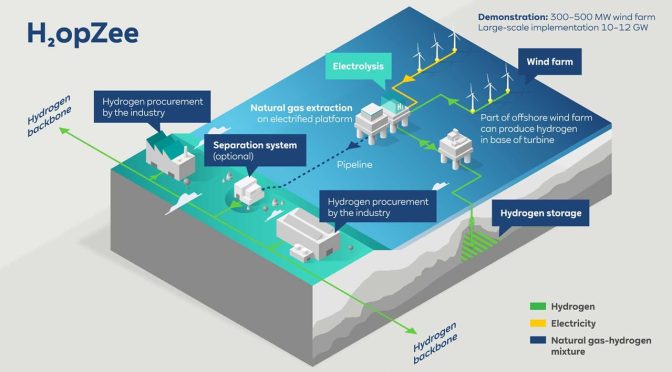RWE and Neptune Energy announced today that they have signed a Joint Development Agreement to develop the offshore green hydrogen demonstration project “H2opZee” ahead of 2030.
H2opZee is a demonstration project which aims at building 300 to 500 megawatts (MW) electrolyzer capacity far out in the Dutch North Sea, in order to produce green hydrogen by using offshore wind. The hydrogen will then be transported to land through an existing pipeline. The pipeline has a capacity of 10 to 12 gigawatts (GW), so it is already suitable for the further roll-out of green hydrogen production to gigawatt scale in the North Sea. The intention is to start the feasibility study in the second quarter 2022. The project is an initiative of TKI Wind op Zee, an initiative supported by the Dutch government that brings people, knowledge and financing together to realize the offshore energy transition.
H2opZee consists of two phases: In the first phase, a feasibility study will be carried out and an accessible knowledge platform set up. The objective of this is to start the roll-out of hydrogen at sea in the Netherlands. In the second phase, the project will actually be implemented. For that phase, a tender methodology has yet to be defined.
Sven Utermöhlen, CEO Offshore Wind, RWE Renewables: “Hydrogen is a gamechanger in the decarbonisation of energy-intensive sectors, and H2opZee is among the world’s first projects of this kind and scale. With Neptune Energy at our side, we want to develop the H2opZee project to demonstrate how offshore wind can be an ideal partner for the production of green hydrogen at scale, and to explore the best approaches to system integration. As RWE, we have a 20 years’ track record in offshore wind and have the hydrogen expertise along the entire value chain under one roof. We are convinced that learnings from the H2opZee demonstration project will help in ramping-up the hydrogen economy in the Netherlands, as it presents an important step towards the roll-out of large-scale green hydrogen production offshore.”
Lex de Groot, Managing Director of Neptune Energy in the Netherlands: “We see an important role for green hydrogen in the future energy supply. It can be produced in our own North Sea. The energy transition can be faster, cheaper and cleaner if we integrate existing gas infrastructure into new systems. This infrastructure is technically suitable. As a result, for example, no new pipeline at sea is needed and no new landfall needs to be made through the coastal area. With the PosHYdon pilot we are one of the leaders in this field of offshore energy system integration and reuse. The lessons learned from this project apply to H2opZee. The faster we can scale up green hydrogen at sea, the faster industry such as chemicals and steel production can become more sustainable. With H2opZee the Netherlands is becoming a world leader in this area. That is why we, together with RWE, are enthusiastic about H2opZee and what it has to offer the Netherlands.”
H2opZee is to realise 300 to 500 MW additional green hydrogen offshore capacity combined with an existing pipeline that can facilitate 10 to 12 GW in the future. The project is among the world’s first of this kind and scale. The gained knowledge and expertise will strengthen the competitive position of Dutch industry, help to establish the value chain of offshore wind and green hydrogen production in the Netherlands, and will deliver technology and knowledge that can be exported worldwide.
H2opZee is one of the 37 proposals submitted for the second round of the National Growth Fund. Consortium partners RWE and Neptune Energy have worked together on the initiative from the very beginning. While the core consortium of H2opZee has been kept small and decisive, knowledge will be shared with the industry and nearly 40 organizations have already signaled their support.


